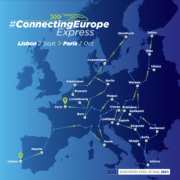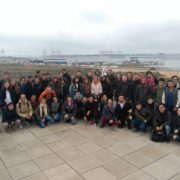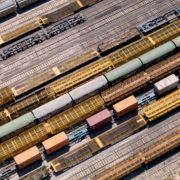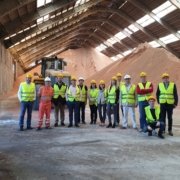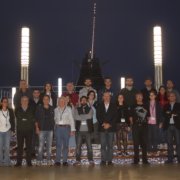Connecting Europe Express

Written by: Lidia Slawinska – Digital Communications Manager Escola Europea – Intermodal Transport
As 2021 is drawing to a close, it is interesting to consider how far rail has progressed this year. With the 2021 Climate Conference highlighting the needs of the developed nations to hasten their efforts to curb CO2 emissions, the concept of rail has gained further promise in the eyes of many European governments. In this #DidYouKnow article, and in anticipation of the 2021 SURCO Operations II course which will take place in the first month of 2022, we decided to focus on one experiment recently launched by the European Union to try to evaluate the status of rail on the European continent – namely the Connecting Europe Express.
What is (was) the Connecting Europe Express?
The project was launched by the European Union to shine a spotlight on the various interoperability issues that currently plague the continent, as well as to highlight the cooperation of many companies and implicated parties from different nations. The project, which involved one train journey, lasted 36 days visiting 26 European countries with the ultimate goal of helping the public better understand what difficulties European rail faces in current times in efforts to become the preferred mode for both passengers and freight.
The actual “Express” comprised 3 gauges trains to allow for transit in all of the countries on the itinerary. Throughout its journey, which began on the 2nd of September 2021, the train traversed 20 000km through 33 border crossings. It made 100 stops and included 5 overnight trips. It did all of this with the support of more than 40 railway partners from numerous European countries. It began its journey in Lisbon (Portugal) and arrived at its final destination in Paris on the 7th of October 2021.
Freight transport in the spotlight
There is no doubt that freight transport has a myriad of advantages over other forms of transport – notably in terms carbon emissions, comfort and cost. Though it is not without faults, it does provide an excellent solution to many transport companies who are seeking to diminish their carbon footprints and help bring to life the climate-protecting goals set by international organisations.
The Connecting Europe Express showed that through rail, both passengers and businesses could benefit. The project also shone a spotlight on the work that the European Union still has left in terms of conflicting and incomplete infrastructures that complicate the train journeys on the continent (the three gauges being one of the complications).
In terms of freight transport, the Express was able to educate the public on the concept of the rolling roads. The train stopped at the Brenner Pass in Austria during its journey – a vital opportunity to highlight the advantages of train for truckers. The Brenner Pass is a connecting point from the road to the “rolling road” – a concept that allows trucks to pass certain segments of their journeys on the trains. The trucks can roll onto the trains, giving the drivers the opportunity to enjoy the comforts of a passenger train carriage. The rolling roads can now transport most types of lorries and have proven to be safe and cost-preserving (with the possibilities of avoiding tolls and fuel charges). The added publicity and awareness that was raised during this stop helped shine some light on such complementary options for truckers and road transport companies.
The European Year Rail
This year has been declared the European Year of Rail. The European Union has spent the year promoting this mode of transport in spite of the complications imposed by the Covid-19 restrictions. The Connecting Europe Express was the EU’s flagship project – it helped both raise awareness for everything that rail has to offer, and to highlight what still must be done to ensure the optimal use of this mode.
Intermodal transport is the lifeline of the Escola Europea, and we have been offering courses that highlight the advantages and disadvantages of the various modes of transport since our inception. Rail became a staple of our courses in 2009 with the launch of SURCO (Simple Use Railway Connections). Our training offer continually adapts to the technological, environmental, and societal changes that take place in the sector, and the courses offer real-life case studies from professionals active in the sector. Our SURCO Operations II course also includes visits to Perpignan, where participants can witness actual rolling road operations in the Le Boulou Lorry Rail terminal.
If you are interested to learn more, you can head to the SURCO page on our website, or find out more about our upcoming course in January here.
Sources:

